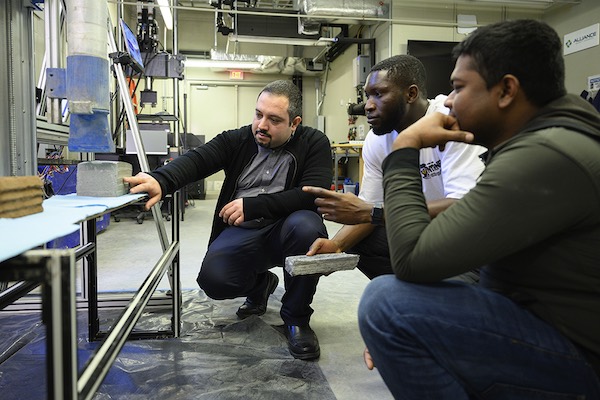Large-Scale 3D Printed Construction Turns to the Moon
LSU Construction Management is partnering with NASA to explore lunar materials for extraterrestrial construction.

LSU Construction Management researchers are exploring use of native raw materials on the moon and Mars to develop 3D printed, waterless concrete. Image Courtesy of LSU Construction Management
Latest News
December 12, 2023
Researchers in LSU College of Engineering are hard at work exploring lunar materials for in-space 3D printing-enabled construction in preparation for NASA’s 2025 journey back to the moon for the first time since 1972.
The Artemis 3 flight plan is to land two astronauts on the moon’s surface to explore its south pole and begin the process of establishing a long-term presence there. Robotic construction technologies are essential to the mission, required to build the habitats, landing pads, radiation shields, and other structures that will comprise the lunar community.
Large-scale 3D printing technology is expected to play a major role in building structures on the moon. But shuttling raw materials between earth and the moon is cost prohibitive, prompting researchers to explore how to effectively leverage on-site lunar materials to fuel the 3D printed construction.
One of those researchers is LSU Bert S. Turner Construction Management Assistant Professor Ali Kazemian. Kazemian is working with two scientists from NASA Marshall Space Flight Center in Alabama – Michael Fiske, technical fellow, and Jennifer Edmunson, project manager and geologist – to research the use of native raw materials readily available on the surface of the moon and Mars, namely sulfur and regolith, to develop 3D-printed waterless concrete.
Molten sulfur will serve as the binder and regolith, the lunar soil found on the moon, acts as the filler material, Kazemian said. “3D printing using sulfur-regolith concrete (SRC) is attractive when you consider that production of Portland cement concrete, the most commonly-used construction material on Earth, will be complicated on the moon,” Kazemian explained “It requires large amounts of water that could otherwise be used for life support or other exploration activities.”
Funded by a $200,198 grant from the National Science Foundation, the research partners will perform their work both at LSU and the NASA Marshall Space Flight Center. LSU will oversee exploration into extrusion parameters and the interplay between material-process-environment factors during high-temperature SRC extrusion. Both partners will handle the testing of the space resilience of 3D-printed SRC specimens at the NASA Marshall Space Flight Center under vacuum conditions and temperature swings, extreme thermal load resistance, and simulated micrometeorite impact resistance.
“The planned research tasks will provide a fundamental understanding of the impacts of high-temperature, extrusion process parameters and environmental factors, such as near-vacuum conditions, on the performance of 3D-printed SRC structures,” Kazemian said. “After reaching these objectives, together with our NASA colleagues, we will work on design and development of a large-scale SRC 3D-printing system at NASA Marshall to validate our research findings on a large scale.” One such experiment will be 3D printing a Lunar habitat analog.
Kazemian said the researchers are currently working on several other projects, all focused on using construction 3D printing to build houses and shelters cheaper and faster, to alleviate the global housing shortage crisis, and for disaster relief applications.
During the NSF project, the team will look into the potential applications of 3D-printed sulfur concrete on earth as well. “Sulfur concrete has unique properties such as superior mechanical strength, rapid hardening, and resilience in acidic and saline environments,” Kazemian said, “The fact that sulfur concrete production does not require water is becoming increasingly important, particularly as more regions and countries around the world struggle to cope with droughts and water scarcity.”
Read this Digital Engineering feature article to learn more about how 3D printing will be used in construction in space as well as other applications.
Watch this video to learn more about NASA’s Artemis 3 mission.
Subscribe to our FREE magazine, FREE email newsletters or both!
Latest News
About the Author
Beth Stackpole is a contributing editor to Digital Engineering. Send e-mail about this article to DE-Editors@digitaleng.news.
Follow DE





